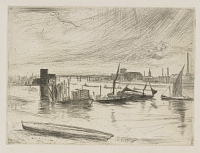Etchings Institutions search term: grolier club
Battersea Dawn (Cadogan Pier) | ||
| Number: | 95 | |
| Date: | 1863 | |
| Medium: | etching and drypoint | |
| Size: | 115 x 153 mm | |
| Signed: | 'Whistler.' at lower left | |
| Inscribed: | no | |
| Set/Publication: | 'Thames Set', 1871 | |
| No. of States: | 2 | |
| Known impressions: | 61 | |
| Catalogues: | K.75; M.75; T.64; W.79 | |
| Impressions taken from this plate (61) | ||
KEYWORD
TITLE
'Batt. Dawn' (1866/1867, Whistler). 1
'Battersea dawn' (1870s, Whistler). 2
'Early Morning (Battersea)' (1871, Ellis & Green). 3
'Cadogan Pier' (1874, Ralph Thomas, Jr (1840-1876)). 4
'Battersea Dawn (Cadogan pier)' (1881, Union League Club). 5
'Cadogan Pier' (1886, Frederick Wedmore (1844-1921)). 6
'Early Morning, Battersea' (1909, Howard Mansfield (1849-1938)). 7
Whistler's early title 'Battersea Dawn' could be confused with the later etching, Battersea Morn [174]. This similarity in titles causes problems in tracking the early history of these works. Edward Guthrie Kennedy (1849-1932) commented: 'The title in the "Sixteen Etchings" was "Early Morning (Battersea)," which Mr Wedmore changed to "Cadogan Pier." The first title is much more in harmony with the effect achieved by the artist, and is, therefore, used.' 8
Rejecting 'harmony' in favour of clarity, the current title, 'Battersea Dawn (Cadogan Pier)', combines Whistler's original title with the name of the site. It was first used by Samuel Putnam Avery (1822-1904) in the Union League Club in 1881, and it is the clearest title.
1: Whistler’s Journal, [February 1866/January 1867], GUW #04335.
3: A Series of Sixteen Etchings of Scenes on the Thames, No. 15.
4: Thomas 1874 (cat. no. 64).
5: New York 1881 (cat. no. 108).
6: Wedmore 1886 A (cat. no. 79).
7: Mansfield 1909 (cat. no. 75).
8: Kennedy 1910 (cat. no. 75).
DESCRIPTION
SITE
The dominant feature is Cadogan Pier, which was built by George Henry Cadogan (1840-1915) as a mooring point for boats on the Thames at Chelsea. It is between Battersea Bridge (which is seen in the background of the etching) and the Albert Bridge (which was not built at the time of Whistler's etching).
9: Wedmore 1886 A (cat. no. 79).
10: Guildhall Library Print Room, Acc. No. p5354263, on-line at http:// collage.cityoflondon.gov.uk (accessed 2008).
DISCUSSION
11: [August 1887/1888], GUW #13233.
12: [1890/1892], GUW #12715.






